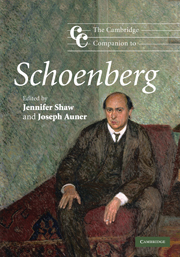Book contents
- Frontmatter
- 1 Introduction
- Part I Schoenberg's early years
- Part II Schoenberg, modernism, and modernity
- Part III Schoenberg between the World Wars
- Part IV Schoenberg's American years
- 15 Cadence after thirty-three years: Schoenberg's Second Chamber Symphony, Op. 38
- 16 Schoenberg's collaborations
- 17 Listening to Schoenberg's Piano Concerto
- 18 Schoenberg reception in America, 1933–51
- 19 Schoenberg: dead or alive? His reception among the postwar European avant-garde
- Notes
- Select bibliography
- Index
19 - Schoenberg: dead or alive? His reception among the postwar European avant-garde
from Part IV - Schoenberg's American years
Published online by Cambridge University Press: 28 September 2011
- Frontmatter
- 1 Introduction
- Part I Schoenberg's early years
- Part II Schoenberg, modernism, and modernity
- Part III Schoenberg between the World Wars
- Part IV Schoenberg's American years
- 15 Cadence after thirty-three years: Schoenberg's Second Chamber Symphony, Op. 38
- 16 Schoenberg's collaborations
- 17 Listening to Schoenberg's Piano Concerto
- 18 Schoenberg reception in America, 1933–51
- 19 Schoenberg: dead or alive? His reception among the postwar European avant-garde
- Notes
- Select bibliography
- Index
Summary
Immediate postwar responses
From the early 1950s onwards, the response of “radical” young European composers to the Schoenberg legacy was highly diverse. On the one hand, in 1951, Pierre Boulez wrote a notorious polemical article announcing that “Schoenberg is Dead”; on the other, one of Luigi Nono's first works was the Variazioni canoniche sulla serie di l'opus 41 di Schoenberg (1950), and in 1955 he established direct family ties by marrying Schoenberg's daughter Nuria (they had met the previous year at Hans Rosbaud's premiere performance of Moses und Aron in Hamburg). For elder spokesmen of the postwar period such as Theodor W. Adorno, Schoenberg was the exemplary apostle of progress, as opposed to the “reactionary” Stravinsky. But precisely this kind of patriarchal espousal aroused suspicion and resistance among the young, to both the dodecaphonic and Neoclassical camps. Of the Second Viennese School, it was often the equally “patriarchal” Schoenberg who was rejected in favor of an emergent Webern mythology on the one hand (initially, the young “Darmstadt generation” was often characterized as post-Webernian), and a fascination with Berg's esoteric late-Romanticism on the other.
Significantly, none of these young Europeans had ever encountered Schoenberg in person. In principle, both Nono and Stockhausen should have done so: one of the main reasons for Stockhausen's going to the 1951 Darmstadt Summer Courses (at the instigation of Herbert Eimert) was that Schoenberg was scheduled to give the composition class, and Nono was there too. But Schoenberg was too ill to travel, and was replaced by Adorno: the latter’s hostile encounter with Stockhausen following a performance of the two middle movements of Karel Goeyvaerts’s Sonata for 2 Pianos (in which Stockhausen had been the second pianist) has often been recounted.
- Type
- Chapter
- Information
- The Cambridge Companion to Schoenberg , pp. 258 - 268Publisher: Cambridge University PressPrint publication year: 2010

